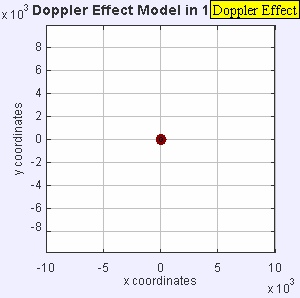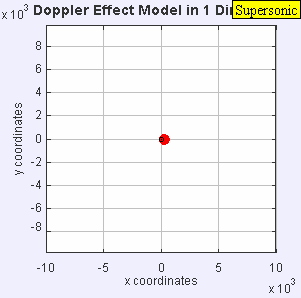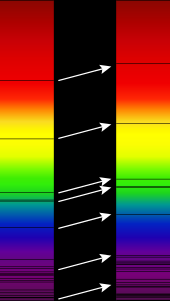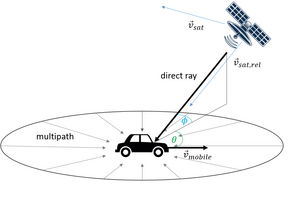
In physics and general relativity, gravitational redshift is the phenomenon that electromagnetic waves or photons travelling out of a gravitational well lose energy. This loss of energy corresponds to a decrease in the wave frequency and increase in the wavelength, known more generally as a redshift. The opposite effect, in which photons gain energy when travelling into a gravitational well, is known as a gravitational blueshift. The effect was first described by Einstein in 1907, eight years before his publication of the full theory of relativity.

In physics, a redshift is an increase in the wavelength, and corresponding decrease in the frequency and photon energy, of electromagnetic radiation. The opposite change, a decrease in wavelength and increase in frequency and energy, is known as a blueshift, or negative redshift. The terms derive from the colours red and blue which form the extremes of the visible light spectrum. The main causes of electromagnetic redshift in astronomy and cosmology are the relative motions of radiation sources, which give rise to the relativistic Doppler effect, and gravitational potentials, which gravitationally redshift escaping radiation. All sufficiently distant light sources show cosmological redshift corresponding to recession speeds proportional to their distances from Earth, a fact known as Hubble's law that implies the universe is expanding.

In physics, the special theory of relativity, or special relativity for short, is a scientific theory of the relationship between space and time. In Albert Einstein's 1905 treatment, the theory is presented as being based on just two postulates:
- The laws of physics are invariant (identical) in all inertial frames of reference.
- The speed of light in vacuum is the same for all observers, regardless of the motion of light source or observer.

A Doppler radar is a specialized radar that uses the Doppler effect to produce velocity data about objects at a distance. It does this by bouncing a microwave signal off a desired target and analyzing how the object's motion has altered the frequency of the returned signal. This variation gives direct and highly accurate measurements of the radial component of a target's velocity relative to the radar. The term applies to radar systems in many domains like aviation, police radar detectors, navigation, meteorology, etc.

The radial velocity or line-of-sight velocity of a target with respect to an observer is the rate of change of the vector displacement between the two points. It is formulated as the vector projection of the target-observer relative velocity onto the relative direction or line-of-sight (LOS) connecting the two points.
Time dilation is the difference in elapsed time as measured by two clocks, either due to a relative velocity between them, or a difference in gravitational potential between their locations. When unspecified, "time dilation" usually refers to the effect due to velocity.

The relativistic Doppler effect is the change in frequency, wavelength and amplitude of light, caused by the relative motion of the source and the observer, when taking into account effects described by the special theory of relativity.

Relativistic beaming is the process by which relativistic effects modify the apparent luminosity of emitting matter that is moving at speeds close to the speed of light. In an astronomical context, relativistic beaming commonly occurs in two oppositely-directed relativistic jets of plasma that originate from a central compact object that is accreting matter. Accreting compact objects and relativistic jets are invoked to explain x-ray binaries, gamma-ray bursts, and, on a much larger scale, active galactic nuclei.

A pulse-Doppler radar is a radar system that determines the range to a target using pulse-timing techniques, and uses the Doppler effect of the returned signal to determine the target object's velocity. It combines the features of pulse radars and continuous-wave radars, which were formerly separate due to the complexity of the electronics.

Continuous-wave radar is a type of radar system where a known stable frequency continuous wave radio energy is transmitted and then received from any reflecting objects. Individual objects can be detected using the Doppler effect, which causes the received signal to have a different frequency from the transmitted signal, allowing it to be detected by filtering out the transmitted frequency.

The Sagnac effect, also called Sagnac interference, named after French physicist Georges Sagnac, is a phenomenon encountered in interferometry that is elicited by rotation. The Sagnac effect manifests itself in a setup called a ring interferometer or Sagnac interferometer. A beam of light is split and the two beams are made to follow the same path but in opposite directions. On return to the point of entry the two light beams are allowed to exit the ring and undergo interference. The relative phases of the two exiting beams, and thus the position of the interference fringes, are shifted according to the angular velocity of the apparatus. In other words, when the interferometer is at rest with respect to a nonrotating frame, the light takes the same amount of time to traverse the ring in either direction. However, when the interferometer system is spun, one beam of light has a longer path to travel than the other in order to complete one circuit of the mechanical frame, and so takes longer, resulting in a phase difference between the two beams. Georges Sagnac set up this experiment in 1913 in an attempt to prove the existence of the aether that Einstein's theory of special relativity makes superfluous.

The Pound–Rebka experiment monitored frequency shifts in gamma rays as they rose and fell in the gravitational field of the Earth. The experiment tested Albert Einstein's 1907 and 1911 predictions, based on the equivalence principle, that photons would gain energy when descending a gravitational potential, and would lose energy when rising through a gravitational potential. It was proposed by Robert Pound and his graduate student Glen A. Rebka Jr. in 1959, and was the last of the classical tests of general relativity to be verified. The measurement of gravitational redshift and blueshift by this experiment validated the prediction of the equivalence principle that clocks should be measured as running at different rates in different places of a gravitational field. It is considered to be the experiment that ushered in an era of precision tests of general relativity.

In atomic physics, Doppler broadening is broadening of spectral lines due to the Doppler effect caused by a distribution of velocities of atoms or molecules. Different velocities of the emitting particles result in different Doppler shifts, the cumulative effect of which is the emission (absorption) line broadening. This resulting line profile is known as a Doppler profile. A particular case is the thermal Doppler broadening due to the thermal motion of the particles. Then, the broadening depends only on the frequency of the spectral line, the mass of the emitting particles, and their temperature, and therefore can be used for inferring the temperature of an emitting body being spectroscopically investigated.
Relativistic aberration is the relativistic version of aberration of light, including relativistic corrections that become significant for observers who move with velocities close to the speed of light. It is described by Einstein's special theory of relativity.

The Ives–Stilwell experiment tested the contribution of relativistic time dilation to the Doppler shift of light. The result was in agreement with the formula for the transverse Doppler effect and was the first direct, quantitative confirmation of the time dilation factor. Since then many Ives–Stilwell type experiments have been performed with increased precision. Together with the Michelson–Morley and Kennedy–Thorndike experiments it forms one of the fundamental tests of special relativity theory. Other tests confirming the relativistic Doppler effect are the Mössbauer rotor experiment and modern Ives–Stilwell experiments.

The Fizeau experiment was carried out by Hippolyte Fizeau in 1851 to measure the relative speeds of light in moving water. Fizeau used a special interferometer arrangement to measure the effect of movement of a medium upon the speed of light.
The photoacoustic Doppler effect is a type of Doppler effect that occurs when an intensity modulated light wave induces a photoacoustic wave on moving particles with a specific frequency. The observed frequency shift is a good indicator of the velocity of the illuminated moving particles. A potential biomedical application is measuring blood flow.
A laser surface velocimeter (LSV) is a non-contact optical speed sensor measuring velocity and length on moving surfaces. Laser surface velocimeters use the laser Doppler principle to evaluate the laser light scattered back from a moving object. They are widely used for process and quality control in industrial production processes.
In astrophysics the chirp mass of a compact binary system determines the leading-order orbital evolution of the system as a result of energy loss from emitting gravitational waves. Because the gravitational wave frequency is determined by orbital frequency, the chirp mass also determines the frequency evolution of the gravitational wave signal emitted during a binary's inspiral phase. In gravitational wave data analysis it is easier to measure the chirp mass than the two component masses alone.
Optical coherence tomography (OCT) is a technique that displays images of the tissue by using the backscattered light.




































































